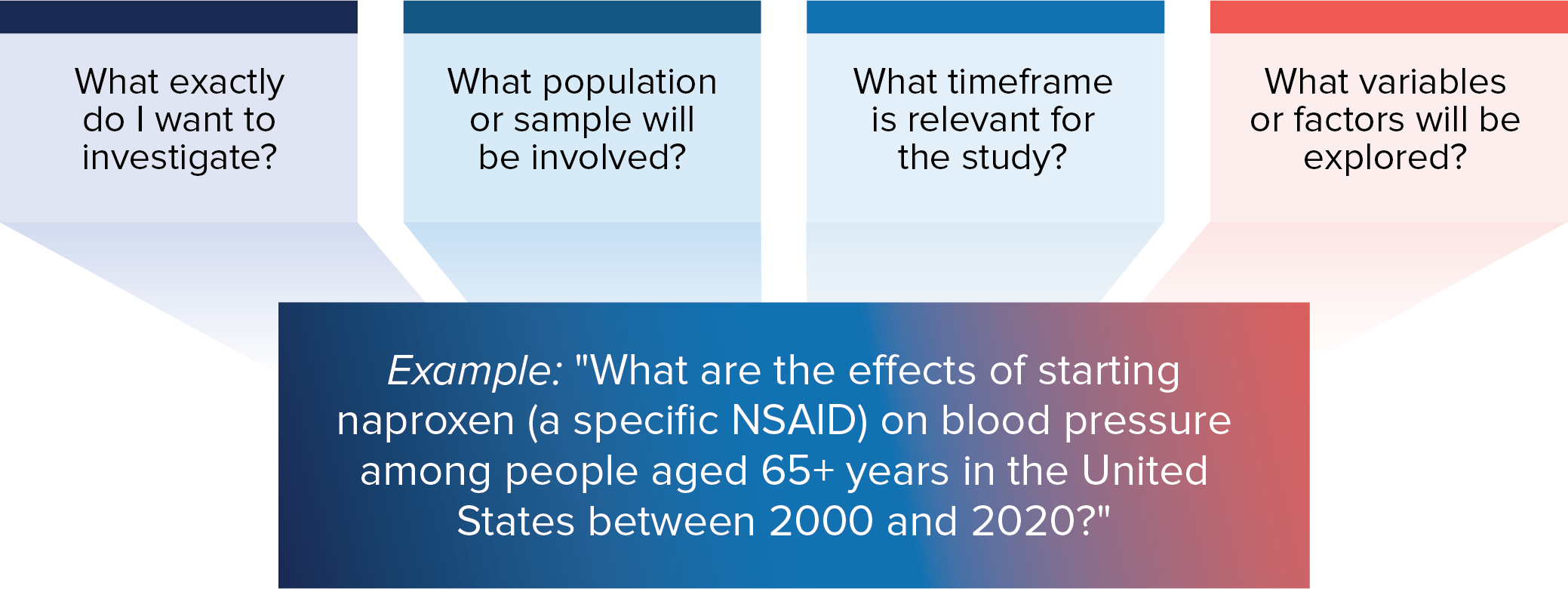
Contributed by
John D. Seeger, PharmD, DrPH
Vice President, Epidemiology
RTI Health Solutions
Formulating Research Questions to Focus on Impact and Efficiency
Formulating a clear and focused research question is one of the most critical stages in conducting meaningful therapeutic research. It guides the direction of the study, narrows the scope, and ensures that the research process remains relevant. However, developing a research question is rarely straightforward, often involving input from varied stakeholders and multiple iterations to convert a general research idea into specific research aims that can feasibly be addressed.
This article explores strategies and approaches to help researchers craft improved research questions. Often, a research topic is supplied at the outset by a funding agency or a client. Even in these settings, further refinement is still needed.
The Importance of a Clear Research Question
A research question serves as the foundation upon which a research program is built. It provides a target that lends direction and clarity to the research effort by focusing on a specific problem, issue, or gap in knowledge and pointing the way for information to address it. By beginning with this purpose in mind, the steps needed to achieve it become clearer. A well-constructed research question enables researchers to:

Far too often I see a mismatch between the research intent and the research actually conducted, which can be traced back to the research question. A research question is always present, whether explicit or implicit, and when it is unfocused, overambitious, or off topic it produces research results that answer a different question than the researcher intended. A well-developed research question enhances alignment between the research results and the need for evidence.
One major contributor to this mismatch between intent and conduct relates to the domain most closely aligned with the research question. Broadly speaking, these domains can be categorized as descriptive (including estimates of incidence/prevalence and identification of potential risk factors) or inferential (including comparative effectiveness or comparative safety, target trial emulation, and causal inference). A common source of error is to try to answer questions in one of these domains using methodologies better suited to the other. While there may be some overlap between these domains and boundaries are elusive, it is good practice to have a clear idea of whether the research question is more descriptive or more inferential in nature, and to use that knowledge as a foundation and guide to the methods to use.
The Process of Refining a Research Question
1. Start Broad
A broad start may seem like the exact opposite of refinement, but it serves to at least define the domain within which further refinement will occur. There will be entire fields of study that are excluded by simply providing a starting point, even if it is broad. It will aid the research by signaling to reviewers the location of the base camp from which the expedition will embark. Provided with a map, the location, and a compass, detours along the scientific journey are less likely.
Example: While starting with the broad topic of "effects of drug therapy," a researcher might narrow the focus to "the effects of nonsteroidal anti-inflammatory drugs (NSAIDs) on blood pressure."
2. Identify the Information Gap to be Addressed
A good therapeutic research question addresses a problem or a gap in existing literature. Finding that gap requires a literature review to identify what has already been studied and what remains unanswered.
Example: While existing studies may examine the effect of NSAIDs on blood pressure, they may have limitations that provide a gap in knowledge for new research.
3. Narrow and Narrow Further
The next step will guide the study toward a clear and actionable outcome. Researchers should consider:

4. Apply the PICOT Framework
The PICOT framework is a tool widely used in healthcare research to refine and focus a research question by identifying the elements of the question that should be defined explicitly and thoughtfully. PICOT stands for Population, Intervention, Comparison, Outcome, and Time. By breaking a research question into these components, researchers can create clear, focused, and manageable questions.
Population: Clearly identify the population of interest.
Intervention: Specify the treatment, exposure, or variable being studied.
Comparison: Determine the baseline or alternative intervention.
Outcome: Define what the researcher aims to measure or observe.
Time: Specify the duration of the intervention or the timeframe for measuring outcomes.
Benefits of Using the PICOT Framework
Answering these questions helps make the study more manageable and targeted. It ensures that the research question addresses an important and relevant issue. From the beginning, it helps assess whether the study is practicable in terms of resources, time, and subject availability. Better to know these things right from the start rather than realize they are not feasible in the middle of a study. And, importantly, using the PICOT method can help researchers choose appropriate study designs and methodologies.
Iterate and Refine
Don’t be afraid to revisit the question multiple times, refining its focus, clarity, and scope. Researchers might begin with an initial question, test it through literature review and preliminary research, and continue to refine it until it is both manageable and research-worthy.
Seek Feedback From Peers and Mentors
Feedback from peers and mentors is crucial in refining a therapeutic research question. Others can often point out aspects of the question that are unclear, too broad, or impractical. Regular feedback ensures that the question is aligned with the research goals and is feasible within the scope of the study.
A refined research question serves as a compass, directing research in a productive and meaningful way. Researchers must be prepared to iterate and refine their questions through continuous engagement with the literature and feedback from peers. Ultimately, a well-crafted research question helps researchers improve the contribution made by their research and helps developers deliver new evidence efficiently.
